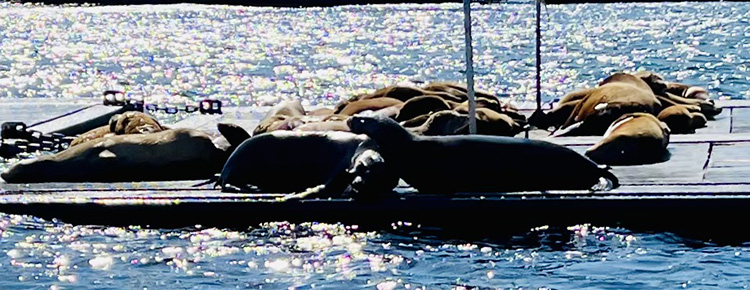
By Donald H. Harrison

SAN DIEGO – When two of my grandchildren arrived for a visit, it was obvious where we should take them. They both are animal lovers, Brian so much so that his bar mitzvah project up in Contra Costa County was in support of two local organizations – Jelly’s Place in San Pablo, which specializes in cat and dog rescues, and the Animal Rescue Foundation (ARF) in Walnut Creek, which describes its mission as “people rescuing animals, and animals rescuing people.” Sara, two years younger, is also very much an animal enthusiast. She’s great at taking photos, even from a moving tram.
So, it was off to San Diego SEAL Tours last Thursday and the San Diego Zoo Safari Park on Friday to engage in what the SEAL Tours’ parent company, Historic Tours of America, calls “edu-tainment,” which refers to educating people while entertaining them.
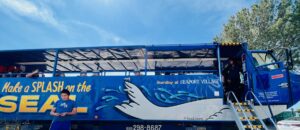
The SEAL tour, utilizing an amphibious vehicle, ironically focuses neither on the Coronado-based Navy SEALs, an elite group of sailors whose missions may be on sea, air, or land, nor on seals, which are rarely seen in San Diego Bay. Instead, the main attraction are sea lions, which sleep and occasionally tussle over position atop the large bait barge off the bayside of Point Loma.
Our guide, Salem, shared with us lots of information about sea lions, including what differentiates them from seals: Sea lions have big flippers upon which they can walk; whereas seals have little flippers on which walking is not possible. Sea lions have ear flaps; seals simply have holes where their ears might be. Sea lions have a solid coat color without patterns, whereas seals have multi-patterned and/or multi-colored coats. Sea lions have a longer nose area, similar to German Shepherds, whereas seals have more compressed noses. Sea lions like to congregate in colonies, like the one on the bait barge in San Diego Bay; seals are more solitary animals.
While sea lions are assumed to have the intelligence of a five-year-old human, seals are “about as smart as a box of rocks,” according to Salem. Because of the sea lions’ intelligence, the U.S. Navy utilizes them as well as Atlantic Bottlenose Dolphins for retrieval of any foreign objects that might find their way into the Bay or the nearby Pacific Ocean. The sea lions are able to dive to great depths and can stay underwater for anywhere between eight and twenty minutes. While on their mission, they can attach flotation devices to whatever foreign objects they may find and thereby bring those objects to the surface.
We took an afternoon tour. Salem disclosed that she and the vessel’s captain, Raymond, were almost certain that we’d find sea lions on the barge because they were there in the morning and “sea lions are capable of sleeping up to 15 hours a day. So, if we see a sea lion hanging out here in the morning, most likely that same sea lion is going to be here taking a nap that same afternoon.”
She also informed us that a male sea lion can weigh up to 900 pounds, whereas the females top out at approximately 250 pounds. Besides their difference in size, male sea lions can be distinguished by a big bump, known as a sagittal crest, atop their heads.
SEAL tour personnel have a standing agreement with SeaWorld San Diego, Salem told us. “When we come out here if we see a sea lion in distress, perhaps stuck in some netting or something like that, we will give SeaWorld a call, and they will send out a team, bring them back to SeaWorld and get them healthy again, and then return them to the wild.”
SeaWorld will place orange tags on the flippers of the rescued sea lions, on the left flipper if the sea lion is a male; on the right flipper if it is a female. “Remember that ladies, females are always right,” Salem quipped.
The day after our SEAL Tour adventure, we were off to San Diego Zoo Safari Park, known formerly as the Wild Animal Park, where we boarded a multi-car tram for a narrated tour around an African-style savannah. Our unidentified male guide pointed out various species, paying particular attention to the Southern White Rhino, various species of giraffe, and to Cape Buffalo.
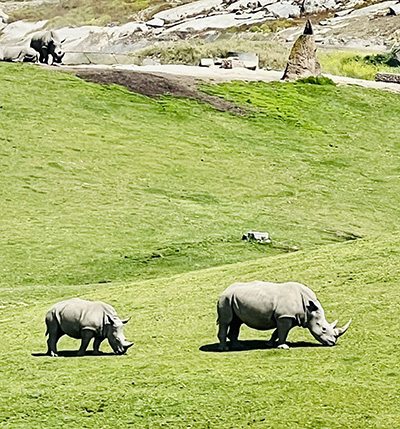
The Southern White Rhinos, we were informed, reach up to 5,000 pounds and are six feet tall at the shoulder. Their social groups are called crashes. Their horns are made of keratin, the same substance as our fingernails, but because some cultures believe they have “medicinal” qualities, poachers have hunted the rhinos to the point that they are threatened with extinction. Our guide used the term “medicinal” rather than “aphrodisiacal,” perhaps to spare parents from having to explain what “aphrodisiacal” means.
While rhinos may look fierce, they are not aggressive, but they will defend themselves if attacked. “They mind their own business.” Their eyes are not very big and their sight is weak. However, they have strong senses of smell and hearing. They have little hair on their bodies, so to protect their sensitive skin from sunburn, they will roll in the mud.
Female Southern White Rhinos are used as surrogates in the effort to save the Northern White Rhino from extinction. Because of poaching, there were only two Northern White Rhinos left in the world. “They can’t recover on their own,” the guide said. “They have a very long gestation period and they have only one calf at a time. Here at the Nikita Kahn Rhino Rescue Center, we have had two Northern White Rhinos born by artificial insemination. … We have a frozen zoo that contains genetic material for thousands of species of wildlife including the Northern White Rhino. We take the genetic material, create an embryo, and that will be inserted in the Southern White Rhino …. At some point we will have more Northern White Rhinos on the planet that we can share with future generations.”
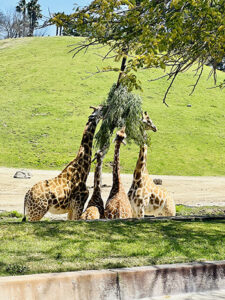
Our guide identified giraffes as a “keystone species,” meaning that if the species were to disappear it would have a major impact on its ecosystem. Giraffes are pollinators that “can reach the highest part of the trees, eat the fruit, and after digestion the seeds are planted, and they grow.” Like the Southern White Rhino, several species of giraffes are facing extinction because of poaching and habitat loss. “Their numbers have declined about 40 percent in the last couple of decades,” our guide informed us. That significant reduction “had gone largely unnoticed until recently, which is why it is called “the silent extinction.”
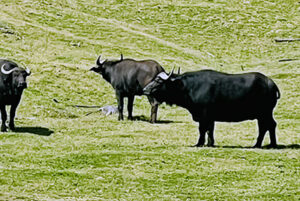
A herd of Cape Buffalo is able to defend itself against predators. “If they are threatened by a pride of lions, they will form a defensive line and stomp them to death,” our guide said. “They are a very effective defensive unit, so even a lame individua can continue to thrive in the herd.” Cape Buffalo also are capable of moving very quickly and can impale animals or humans who seem to threaten them.
San Diego County is a wonderful place to see and learn about animals. Besides these two attractions, there are, of course, such places as the main San Diego Zoo, SeaWorld, Birch Aquarium, the San Diego Humane Society, whale watching expeditions, and various back country rescue operations, among them Lions, Tigers, and Bears; the Children’s Nature Retreat; and the Oasis Camel Dairy. Even more can be learned about animals, living and extinct, at the Natural History Museum in Balboa Park.
*
Donald H. Harrison is editor emeritus of San Diego Jewish World. He may be contacted via donald.harrison@sdjewishworld.com